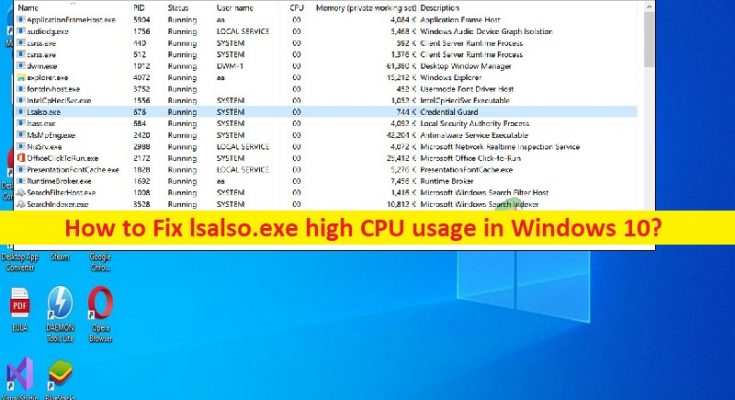What is ‘lsalso.exe high CPU usage’ issue in Windows 10?
If you are facing lsalso.exe high CPU usage issue and looking for ways to fix the issue, then you are in right-place for the solution. Here, you are provided with easy steps/methods to resolve the issue. Let’s starts the discussion.
‘lsalso.exe high CPU usage’ issue:
‘lsalso.exe’: lsalso.exe is executable file relating to Credential Guard and KeyGuard process designed & developed by Microsoft. The process/program of this executable file runs in secure environment called VSM (Virtual Secure Mode) as IUM (Isolated User Mode) process. VSM protects process or programs like lsalso.exe by using isolation process called ‘VLT (Virtual Trust Level)’.
Windows 10 and Windows Server 2016 changed LSASS (Local Security Authority SubSystem Service) process, which managed security policy, user authentication, and auditing while also handling sensitive data like hashed passwords and kerberos keys. However, several users reported they faced lsalso.exe high CPU usage issue on their Windows 10 computer that is causing system performance slowdown issue as well.
When you open Task Manager app in Windows computer in order to check which process/program is causing system performance slowdown issue, you may experience lsalso.exe is showing higher percentage under ‘CPU’ usage section and causing slowdown system performance issue. It is possible to fix the issue with our instructions. Let’s go for the solution.
How to fix lsalso.exe high CPU usage in Windows 10?
Method 1: Fix lsalso.exe high CPU usage using ‘PC Repair Tool’
‘PC Repair Tool’ is easy & quick way to find and fix BSOD errors, DLL errors, EXE errors, problems with programs/applications, malware or viruses infections in computer, system files or registry issues, and other system issues with just few clicks.
Method 2: Use the process of elimination

You can try to fix the issue by eliminating some processes that is causing issue.
Step 1: Press ‘CTRL + SHIFT + ESC’ keys on keyboard to open ‘Task Manager’ app
Step 2: Under ‘Processes’ tab, right-click on suspicious application and select ‘End Task’ to close them and then check if the issue is resolved.
Step 3: If not, open ‘Device Manager’ via Windows Search Box, right-click on device driver that is causing issue or showing Yellow Mark on it, and select ‘Uninstall’ to uninstall it.
Step 4: Once uninstalled, restart your computer and restarting commuter will automatically reinstall all necessary drivers. Once done, restart your computer and check if the issue is resolved.
Method 3: Check for Queued APCs

Microsoft has developed several debugging tools for Windows designed to help you to check for the problems.
Step 1: Open your browser and visit ‘https://support.microsoft.com/en-us/windows/wdk-download-for-windows-10-d1bf01fe-4aa7-497b-5fec-a904db8a40bc’ page to download and install ‘Windows Driver Kit’
Step 2: Use ‘NotMyFault.exe’ to generate a kernel memory dump during the spike and to enable kernel memory, press ‘Windows + R’ keys on keyboard, type ‘control system’ and hit ‘Ok’ button and click ‘Advanced System settings’
Step 3: Click ‘Advanced’ tab in System Properties window. Click ‘Settings’ button associated with Startup and Recovery
Step 4: Expand the dropdown for ‘Write Debugging Information’ and choose ‘Kernel memory dump’ and hit ‘Ok’ button to Dump File Location here.
Step 5: Go to ‘Windows Kits entry > WinDbg(x64/x86)’, click ‘File > Symbol File Path’, type https://msdl.microsoft.com/download/symbols for the Microsoft Symbol Server in the Symbol path section.
Step 6: Click ‘Ok’ and access File Menu again and choose ‘Open Crash Dump’ and browse the location you noted, and click ‘Open’, type ‘!apc’ in command Window and hit ‘Enter’ key
Step 7: Once executed, look for <ProblemDriver>.sys under LsaIso.exe. and check if the issue is resolved.
Conclusion
I am sure this post helped you on How to fix lsalso.exe high CPU usage in Windows 10 with easy ways. You can read & follow our instructions to do so. That’s all. For any suggestions or queries, please write on comment box below.



